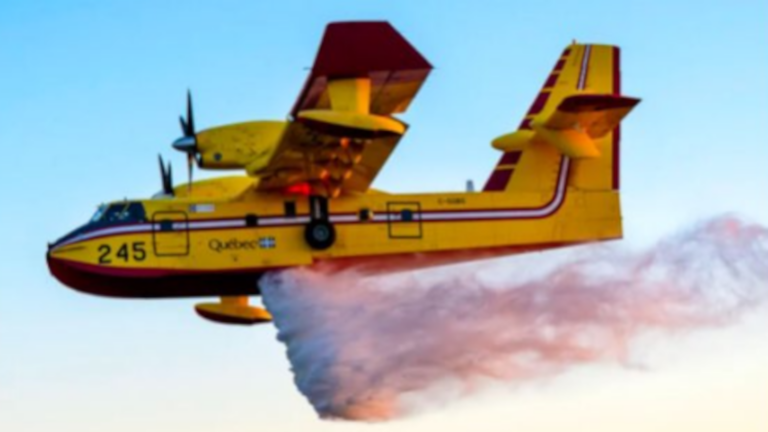The FAA, California Department of Forestry and Fire Protection (CAL FIRE), and other authorities have a simple but urgent message for drone pilots in the Los Angeles area: “If you fly, we can’t.”
The warning comes after an unauthorized drone punched a fist-sized hole in a Bombardier Canadair CL-415 firefighting aircraft, also known as a “Super Scooper,” that was dousing Los Angeles-area wildfires on Thursday. The aircraft landed safely, the FAA said. But CAL FIRE told The War Zone that the collision prompted a temporary grounding of all aircraft responding to the Palisades Fire. The FBI is searching for the drone pilot and has shared photos of the recovered drone.
Drones are particularly dangerous to firefighting aircraft because they occupy the same low-altitude airspace. In recent years, the FAA has documented more than 100 unauthorized drones flying near wildfires.
“Unauthorized UAS [uncrewed aircraft systems] flights could lead fire managers to suspend aerial wildfire suppression operations—such as airtankers dropping fire retardant and helicopters dropping water—until the UAS has left the airspace and they are confident it won’t return,” reads a toolkit posted on the agency’s website.
The regulator typically creates temporary flight restrictions (TFR) around wildfire-ravaged areas, several of which are active in California. It can suspend or revoke unauthorized drone operators’ licenses or hit them with civil penalties up to $75,000. Even when there is no TFR, interfering with aerial firefighting is a federal crime punishable with up to one year in jail.
Still, a local official over the weekend told KNBC-TV in Los Angeles that the number of unregistered drones canvassing the blazes is “well into the double digits.” The FAA told FLYING that fire officials have reported “multiple, unauthorized drones” within the TFRs.
At least three people have been arrested for flying drones over the fires, KXLH-TV News in Helena, Montana, reported, though it is unclear if they are connected to the Super Scooper collision. Officials told the outlet the downed aircraft could be back in service as soon as Tuesday.
What’s in the Air?
The Super Scooper grounded by a drone last week—an amphibious plane sent from Canada called Quebec 1—is just one of more than 80 helicopters, airtankers, tactical planes, and other aircraft battling the California blazes.
According to its website, CAL FIRE’s civil aerial firefighting fleet—comprising more than 60 fixed and rotary wing aircraft stationed at 24 bases across California—is the largest in the world, capable of reaching almost any fire in the state within 20 minutes.
The department uses tactical planes, such as the North American-Rockwell OV-10 Bronco, to survey wildfires, helping other aircraft determine where to drop water or serving as a lead aircraft. It operates 15 OV-10As and one OV-10D acquired from the U.S. Department of Defense (DOD) and NASA, as well as a pair of Beechcraft King Air 200’s for training.
One of CAL FIRE’s newest additions, the Lockheed C-130 Hercules, is often the first to arrive at the scene of a fire, releasing an initial wave of retardant in front of its path. The U.S. Coast Guard last year transferred seven of them to the department, which first deployed the air tankers in August.
Capable of holding 4,000 gallons, the C-130H’s are complemented by 23 smaller Grumman S-2T’s, each with about 1,200 gallons of capacity. Other CAL FIRE air tankers—such as the McDonnell Douglas DC-10, which boasts 9,400 gallons of capacity—are even larger. Until 2021, it flew a specially converted Boeing 737 with double the DC-10’s capacity.
Then there are the Super Scoopers, which scoop water out of nearby oceans, lakes, or reservoirs to douse flames. In addition to the CL-415, CAL FIRE uses a Bombardier 415.
Rounding out the fleet are an array of different helicopters, which often carry buckets of water. The department is working to replace its aging Bell UH-1H Super Hueys with brand new Sikorsky S70i CAL FIRE Hawks, which are equipped with special hoists to airlift stranded firefighters or civilians. Conversely, a C-23B Sherpa and Dornier Do-228 are used by smokejumpers—highly trained firefighters who parachute into fires—to get closer to blazes.
According to a social media post from California Governor Gavin Newsom, 71 helicopters and 13 airtankers have been deployed to snuff out the Los Angeles-area wildfires. Among them are eight military C-130H’s converted with Modular Aerial Fire Fighting Systems (MAFFS), delivered by the U.S. Coast Guard and Air National Guard from California, Nevada, Wyoming, and Colorado at CAL FIRE’s request.
U.S. Northern Command said it can supply more help if requested, including “rotary wing support, ground and air search and rescue, commodity distribution, emergency route clearance, incident awareness and assessment, and medical capabilities.” The DOD on Friday, meanwhile, said it was preparing to send in 10 Navy helicopters with water buckets.
As of Tuesday afternoon, 25 people have died in the Eaton and Palisades fires, and severe wind conditions are expected to continue fueling the blazes throughout the week.



